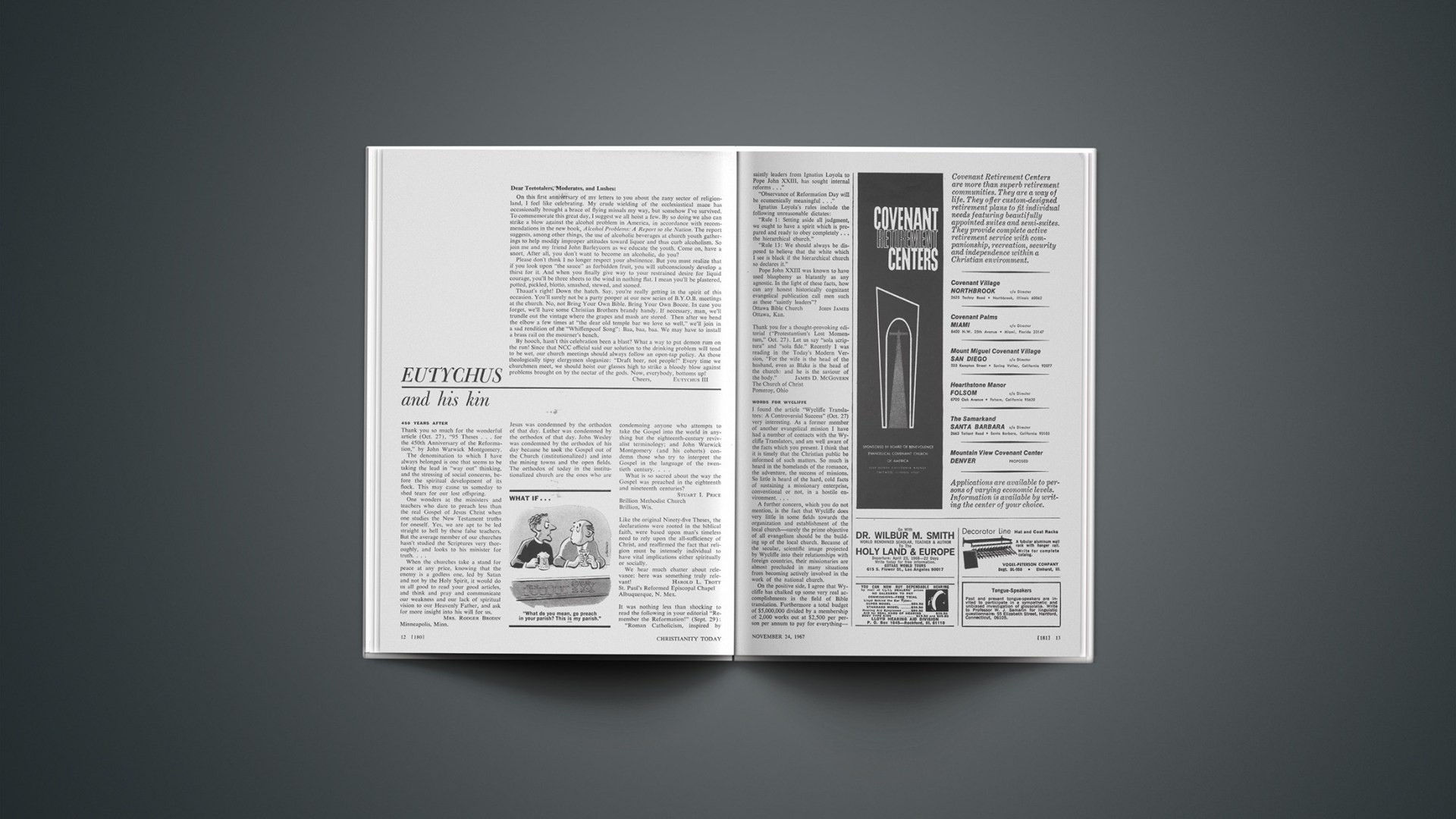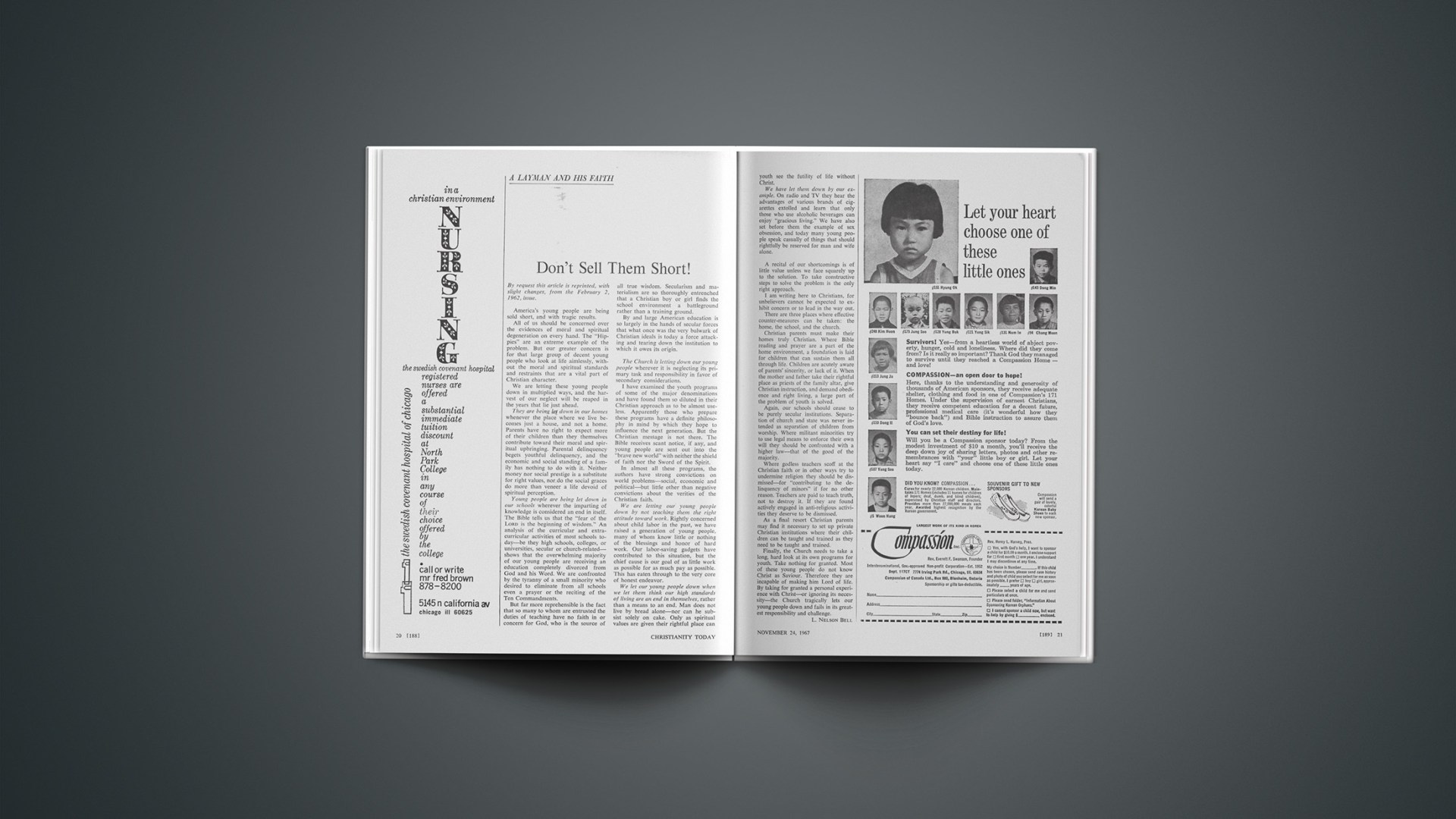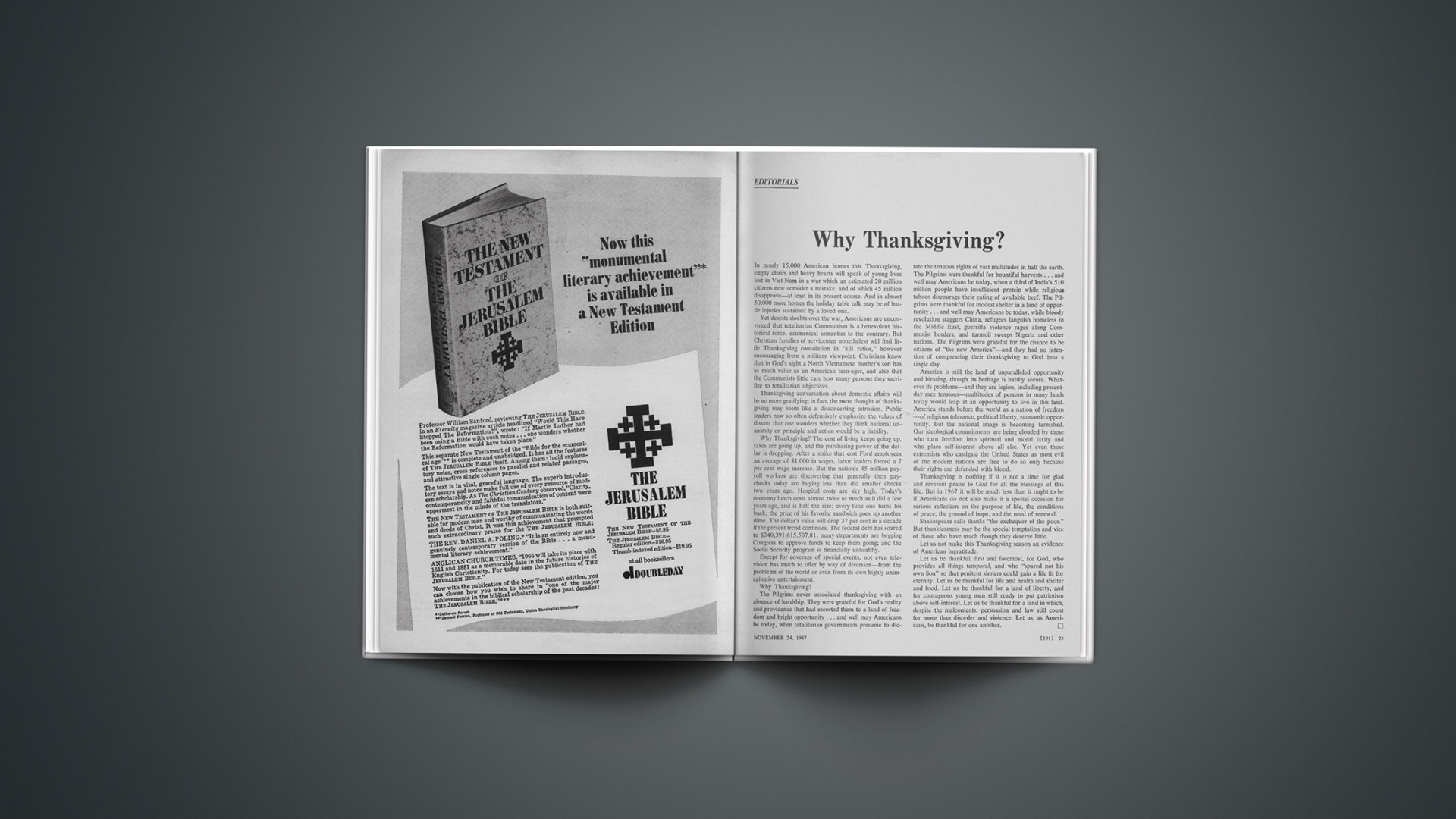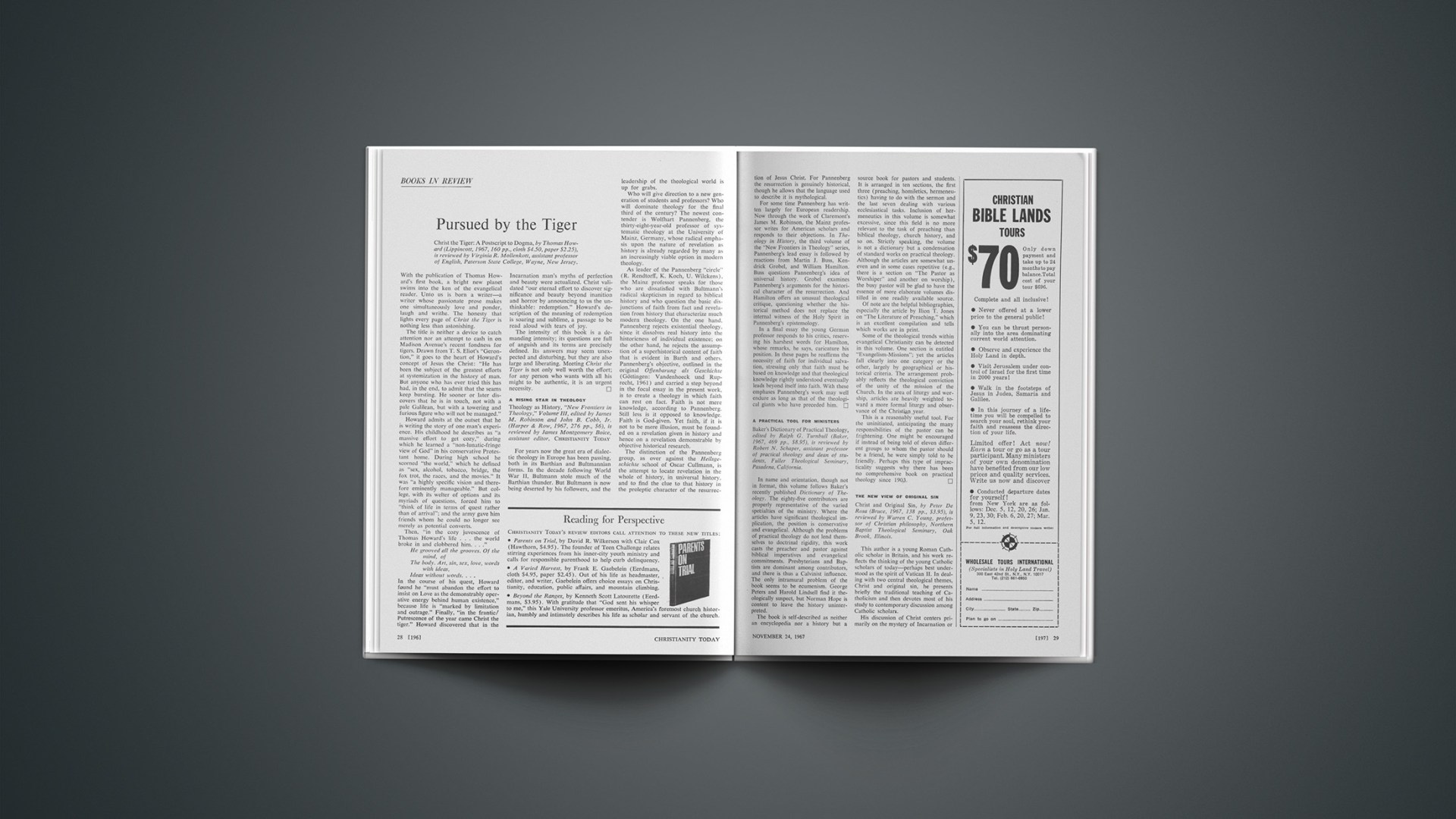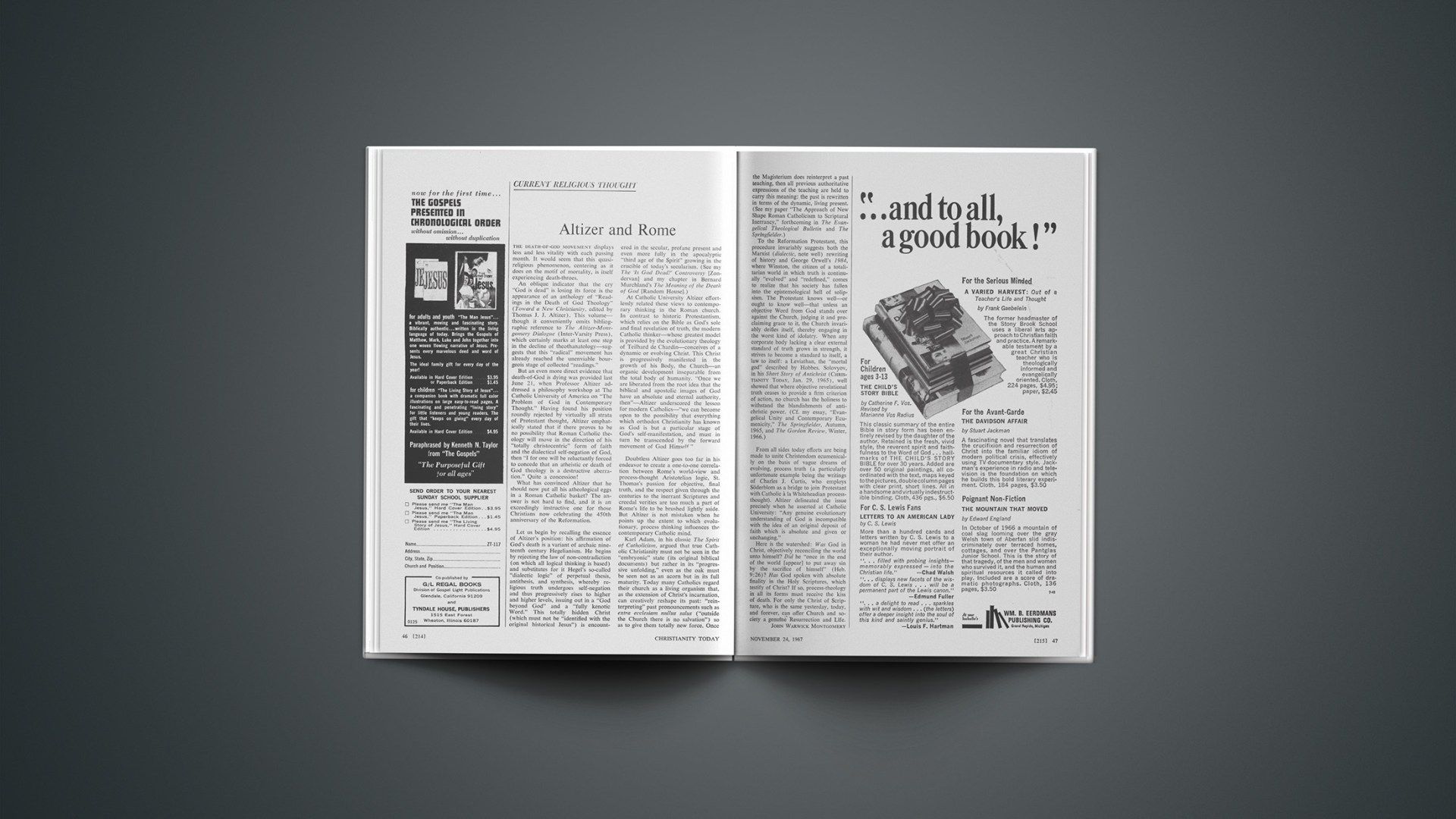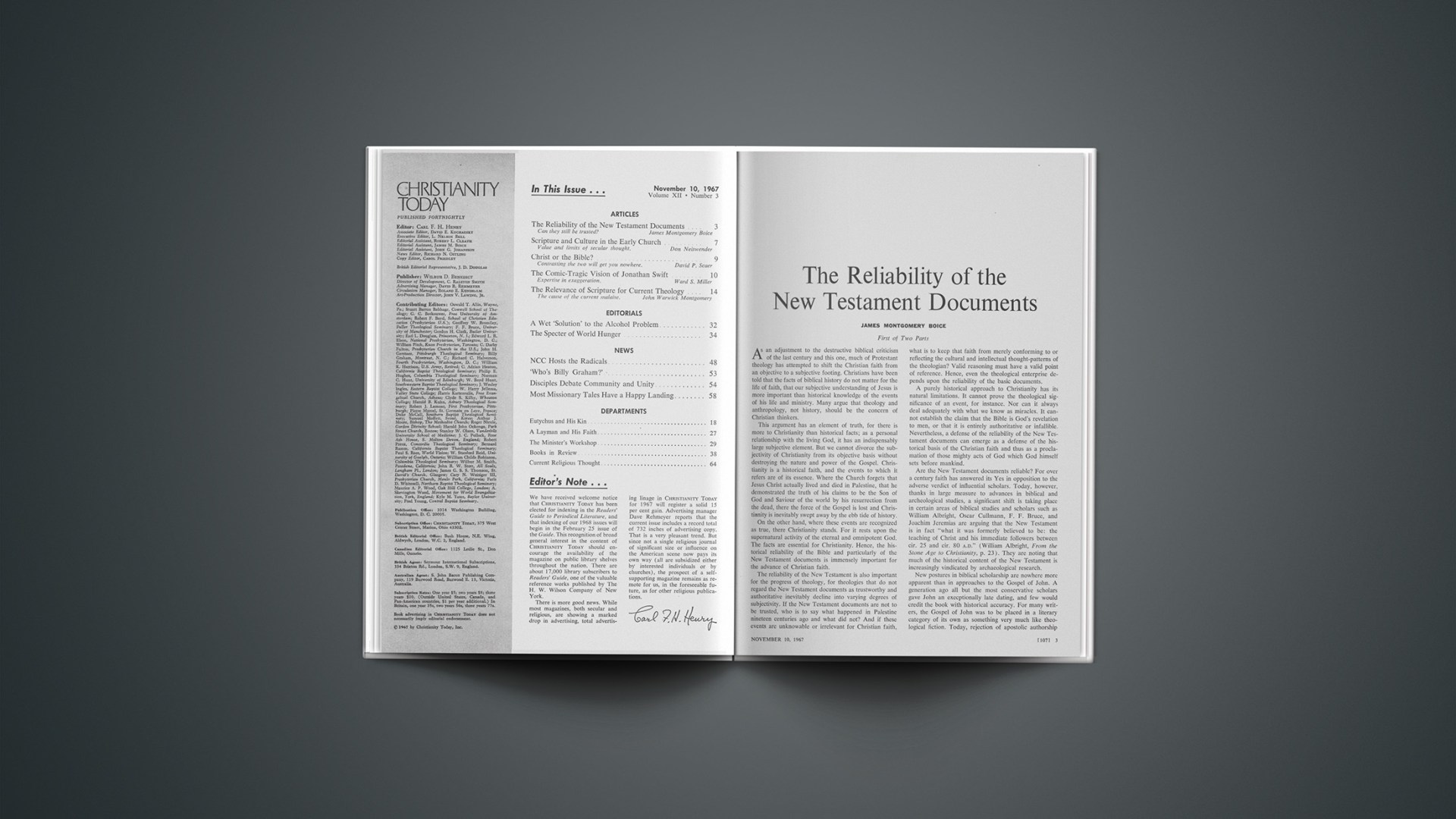Dear Teetotalers, Moderates, and Lushes:
On this first anniversary of my letters to you about the zany sector of religion-land, I feel like celebrating. My crude wielding of the ecclesiastical mace has occasionally brought a brace of flying missals my way, but somehow I’ve survived. To commemorate this great day, I suggest we all hoist a few. By so doing we also can strike a blow against the alcohol problem in America, in accordance with recommendations in the new book, Alcohol Problems: A Report to the Nation. The report suggests, among other things, the use of alcoholic beverages at church youth gatherings to help modify improper attitudes toward liquor and thus curb alcoholism. So join me and my friend John Barleycorn as we educate the youth. Come on, have a snort. After all, you don’t want to become an alcoholic, do you?
Please don’t think I no longer respect your abstinence. But you must realize that if you look upon “the sauce” as forbidden fruit, you will subconsciously develop a thirst for it. And when you finally give way to your restrained desire for liquid courage, you’ll be three sheets to the wind in nothing flat. I mean you’ll be plastered, potted, pickled, blotto, smashed, stewed, and stoned.
Thaaat’s right! Down the hatch. Say, you’re really getting in the spirit of this occasion. You’ll surely not be a party pooper at our new series of B.Y.O.B. meetings at the church. No, not Bring Your Own Bible. Bring Your Own Booze. In case you forget, we’ll have some Christian Brothers brandy handy. If necessary, man, we’ll trundle out the vintage where the grapes and mash are stored. Then after we bend the elbow a few times at “the dear old temple bar we love so well,” we’ll join in a sad rendition of the “Whiffenpoof Song”: Baa, baa, baa. We may have to install a brass rail on the mourner’s bench.
By hooch, hasn’t this celebration been a blast? What a way to put demon rum on the run! Since that NCC official said our solution to the drinking problem will tend to be wet, our church meetings should always follow an open-tap policy. As those theologically tipsy clergymen sloganize: “Draft beer, not people!” Every time we churchmen meet, we should hoist our glasses high to strike a bloody blow against problems brought on by the nectar of the gods. Now, everybody, bottoms up!
Cheers,
EUTYCHUS III
450 YEARS AFTER
Thank you so much for the wonderful article (Oct. 27), “95 Theses … for the 450th Anniversary of the Reformation,” by John Warwick Montgomery.
The denomination to which I have always belonged is one that seems to be taking the lead in “way out” thinking, and the stressing of social concerns, before the spiritual development of its flock. This may cause us someday to shed tears for our lost offspring.
One wonders at the ministers and teachers who dare to preach less than the real Gospel of Jesus Christ when one studies the New Testament truths for oneself. Yes, we are apt to be led straight to hell by these false teachers. But the average member of our churches hasn’t studied the Scriptures very thoroughly, and looks to his minister for truth.…
When the churches take a stand for peace at any price, knowing that the enemy is a godless one, led by Satan and not by the Holy Spirit, it would do us all good to read your good articles, and think and pray and communicate our weakness and our lack of spiritual vision to our Heavenly Father, and ask for more insight into his will for us.
MRS. RODGER BRODIN
Minneapolis, Minn.
Jesus was condemned by the orthodox of that day. Luther was condemned by the orthodox of that day. John Wesley was condemned by the orthodox of his day because he took the Gospel out of the Church (institutionalized) and into the mining towns and the open fields. The orthodox of today in the institutionalized church are the ones who are condemning anyone who attempts to take the Gospel into the world in anything but the eighteenth-century revivalist terminology; and John Warwick Montgomery (and his cohorts) condemn those who try to interpret the Gospel in the language of the twentieth century.…
What is so sacred about the way the Gospel was preached in the eighteenth and nineteenth centuries?
STUART I. PRICE
Brillion Methodist Church
Brillion, Wis.
Like the original Ninety-five Theses, the declarations were rooted in the biblical faith, were based upon man’s timeless need to rely upon the all-sufficiency of Christ, and reaffirmed the fact that religion must be intensely individual to have vital implications either spiritually or socially.
We hear much chatter about relevance; here was something truly relevant!
HAROLD L. TROTT
St. Paul’s Reformed Episcopal Chapel
Albuquerque, N. Mex.
It was nothing less than shocking to read the following in your editorial “Remember the Reformation!” (Sept. 29):
“Roman Catholicism, inspired by saintly leaders from Ignatius Loyola to Pope John XXIII, has sought internal reforms …”
“Observance of Reformation Day will be ecumenically meaningful …”
Ignatius Loyola’s rules include the following unreasonable dictates:
“Rule 1: Setting aside all judgment, we ought to have a spirit which is prepared and ready to obey completely … the hierarchical church.”
“Rule 13: We should always be disposed to believe that the white which I see is black if the hierarchical church so declares it.”
Pope John XXIII was known to have used blasphemy as blatantly as any agnostic. In the light of these facts, how can any honest historically cognizant evangelical publication call men such as these “saintly leaders”?
JOHN JAMES
Ottawa Bible Church
Ottawa, Kan.
Thank you for a thought-provoking editorial (“Protestantism’s Lost Momentum,” Oct. 27). Let us say “sola scriptura” and “sola fide.” Recently I was reading in the Today’s Modern Version, “For the wife is the head of the husband, even as Blake is the head of the church: and he is the saviour of the body.”
JAMES D. MCGOVERN
The Church of Christ
Pomeroy, Ohio
WORDS FOR WYCLIFFE
I found the article “Wycliffe Translators: A Controversial Success” (Oct. 27) very interesting. As a former member of another evangelical mission I have had a number of contacts with the Wycliffe Translators, and am well aware of the facts which you present. I think that it is timely that the Christian public be informed of such matters. So much is heard in the homelands of the romance, the adventure, the success of missions. So little is heard of the hard, cold facts of sustaining a missionary enterprise, conventional or not, in a hostile environment.…
A further concern, which you do not mention, is the fact that Wycliffe does very little in some fields towards the organization and establishment of the local church—surely the prime objective of all evangelism should be the building up of the local church. Because of the secular, scientific image projected by Wycliffe into their relationships with foreign countries, their missionaries are almost precluded in many situations from becoming actively involved in the work of the national church.
On the positive side, I agree that Wycliffe has chalked up some very real accomplishments in the field of Bible translation. Furthermore a total budget of $5,000,000 divided by a membership of 2,000 works out at $2,500 per person per annum to pay for everything—a very real indication of the measure of personal sacrifice involved.
F. J. SMITH
Brantford, Ont.
The rather picayunish charges listed as sometimes hurled at Wycliffe by evangelical missionaries may miss the real issue.… More significant is the role that Wycliffe and others have played in siphoning a disproportionate amount of missionary resources from strategic, high-population areas to sparsely populated tropical rain forests. In some instances, and Ecuador might be an example, Wycliffe seems to have set up an expensive parallel to existing missionary outreach to indigenous tribes. A more appropriate alternative in such countries would have been for Wycliffe to have sent linguistic specialists to cooperate with translators already working in the tribes.
This is written from a background of twelve years of personal overseas experience in which warm friendship and mutual cooperation was developed between our missionary staff and translators from the Summer Institute of Linguistics.
PAUL ERDEL
Foreign Secretary
The Missionary Church Association
Fort Wayne, Ind.
The article [says], “Total Wycliffe membership stands at nearly 2,000, making it the world’s largest Protestant missionary organization.”
I would not detract from Wyclffe’s great accomplishments, but for the sake of accuracy I call attention to the fact that the “overseas” missionary force of the Southern Baptist Convention stood at 2,279 as of September 1.
M. O. OWENS, JR.
Parkwood Baptist Church
Gastonia, N. C.
• We erred in crediting Wycliffe with the title “world’s largest.” Apologies to the rightful claimants, the redoubtable Southern Baptists.—ED.
A MEANS TO THE END?
Your editorial on “the Danger of Christian-Marxist Dialogue” (Oct. 27) demonstrated to me your lack of faith in the providence of God, a misunderstanding of the ultimate need of man for God, and an ignorance of religious life in Russia.…
Could it not be that God in his providential care is working through the “revisionists, demythologized, dedogmatized” Marxists to bring once again freedom and the Gospel of our Lord to the Russian people and other suppressed peoples of the Communist world?…
We criticize their bond of “humanistic orientation” and “the need for revolutionary political action.” Evangelicals may not be able to go the whole route with either the Communists or the secularist theologians, but the living and written Word certainly does not disengage us from humane concerns and social, political action. My biblical faith and understandings portray a revolutionary Gospel.
There may be dangers in such dialogue, but since when do we operate out of a fear to communicate rather than out of passionate concern to use any means at our disposal to glorify Christ that men might know the benefits of his Kingdom? May the spirit of love rather than the spirit of fear push us. May faith in a providential God rather than a stale belief in a God boxed in by creeds motivate us to be where creative possibilities exist to redeem man and society.
MYRON R. CHARTIER
Baptist Campus Center
Hays, Kan.
COUNCIL COUNSEL
After reading “The Council and the Bible” (Oct. 27), this thought occurred to me: Why was not Dr. Hughes invited to write the “Response” to the Constitution on Divine Revelation in The Documents of Vatican II? His sympathetic understanding combined with incisive critique stand in sharp contrast to the vapid ramblings of the response contributed by Dr. F. C. Grant. Could it be that the Roman church is invincibly ignorant of the existence of evangelical scholarship?
WILLIAM S. SAILER
Evangelical Congregational School of Theology
Myerstown, Pa.
THE WAY IT IS
The carefully worded news item (“Church Anti-Poverty Problems,” Oct. 27) concerning Senator James Eastland’s declaration on the Senate floor concerning the Child Development Group of Mississippi still manages to discredit the United Presbyterian Board of National Missions as the administration office of the project.…
You should have been cognizant of the attitude of a man who represents Mississippi, a state where every effort to aid the Negro is hindered, even if it means the murder of civil-rights workers and the burial of their bodies in an earthen dam, and the mass display of the emblem of rebellion by the spectators at the nationally televised football game at the state university.
H. GLENN STEPHENS
Adena-Harrisville United Presbyterian Churches
Adena, Ohio
SOCIAL WORK
Traditional fundamental Christianity has been accused of emphasizing individualistic salvation in the spiritual sphere to the neglect of social improvement. How inaccurate this accusation is, is highlighted in Christiana Tsai, Queen of the Dark Chamber:
Who can estimate the results of missionary service in China? It made Christ known; it built churches, schools, orphanages and hospitals far and wide; it opened the door for women to enter the schools and have the same opportunities as men; it helped rouse the people to the evils of foot binding for women, and opium smoking; it healed the sick and brought comfort to the blind, the deaf, the dumb and the lepers; it brought knowledge of sanitation, fed famine victims, and cared for the war sufferers; it helped prepare Chinese of the following generation to take over the missionaries’ work, to carry on their own evangelistic campaigns, and build their own churches; it showed the infinite value of a human soul in God’s eyes, and wherever the light of the Gospel shown, it enlightened that society so that it soon outstripped other places in its progress toward modern culture.
I earnestly hope that the pages of CHRISTIANITY TODAY will continue to point up the total values of the Gospel of our Lord Jesus Christ. LESTER E. PIPKIN Appalachian Bible Institute President Bradley, W. Va.
GOOD DEAL!
Since you are mending your ways by dropping the freeloaders, I have decided to mend mine by a clean confession and a renewal of my subscription by accepting the deal you have made.
BILL G. CAMPBELL
Southland Baptist Church
Houston, Tex.
Thank you for the many free copies of your journal. I am enclosing a very modest check, in token of my appreciation, as a gift. I myself am liberal in my outlook but have profited by your publication, and it has enriched my sermons.
CLARENCE NETH
Columbia Station, Ohio
My thanks to … the entire staff for so fine a magazine. The world needs magazines like yours, and I hope that it will never suffer as so many other good Christian magazines have suffered. I am enclosing my check to cover a year’s subscription.
E. JAMES CAIN
First Baptist Church
Elko, Nevada
For my money, CHRISTIANITY TODAY just has to be one of the best of today’s journals, irrespective of classification. This is evident from the fact that my Christianity Today gift-subscription list is the longest of all such lists.
JOHN F. SCHMIDT
Peoria, Ill.
CHRISTIANITY TODAY will reinforce every aspect of my ministry.…
CECIL F. MCKEE
Department of Corrections Chaplain
Huntsville, Tex.
I take this opportunity to congratulate you on producing an evangelical magazine that I don’t feel uneasy about lending.
DENNIS G. PAPE
Recife, Pernambuco, Brazil
BANG!
The October 13 cover was armed with a delayed-action fuse. After careful surveillance of the menacing fieldpiece topping a formidable offensive arsenal, I did a double take at spotting the tracer and spent projectile of the secularist salvo.
OVERTON W. BROWN
Chiapas, Mexico
SPACIOUS TOGETHERNESS?
Immediately following an editorial which seems to plead for the united thrust of evangelicals upon a divided world for the salvation of mankind (“Ours Is the Generation,” Oct. 13) comes the editorial concerning the need and nature of conversion (“The Urgency of Personal Conversion”). In stating that “Christianity proclaims original sin” the writer once again has driven the dividing wedge between myself and him. If we are ever going to get together we had better allow a little more room in the areas of opinion of our theology or we shall remain poles apart.
RICHARD L. JONES
Westfield Church of Christ
Porterville, Calif.
THE TIE THAT BINDS
Your news story, “ ‘Divided They Merge’ ” (Oct. 13), and its poll were most interesting. If your poll of the faith of the Missouri Synod ministry is correct, it would appear that a small minority of the Synod’s spiritual leaders are masters of mendacity. Some of the questions are poorly worded. However, faith in Christ’s physical resurrection and virgin birth, a personal devil, and a divine judgment with positive and negative consequences have always been accepted by the Synod. All pastors and teachers are required to accept the Scriptures, the three ecumenical creeds, and the Lutheran Symbols which teach these doctrines. It seems to me that any minister who no longer holds these basic beliefs is obligated by honesty to deny them openly and to withdraw from the Synod, which still accepts them (e.g. The New York Convention, summer, 1967). I would not regard such a minister as my co-worker in Christ, and it seems that the last verse of the Athanasian Creed supports this belief.
DONALD POHLERS
Sea Cliff, N.Y.
EPISCOPALIANS EXPLAIN
Thank you for the rather full coverage given to the General Convention of the Episcopal Church (News, Oct. 13). But why must such reporting always tend to be so quantitative?…
The provision for trial use of the “New Liturgy” got pushed to a mere mention at the conclusion of your article. With the ecclesiastical body’s celebration of the Mass being the most thoroughly Christian action possible—the beginning and end and central action of our lives on earth—is it not much more consistent to give such action of the convention more than a mere notice? Certainly it is more significant than much of the superficial matter so thoroughly covered in your article. The last revision of our Prayer Book was effected in 1928, and a very minor one at that. Our Eucharistic Liturgy has been practically the same since its adoption in 1789–178 years! And practically all the revisions since the 1552 English Liturgy have been attempts to “patch up” the work of Cranmer since he abandoned what was essentially his English translation of the Latin Mass of 1549. Now we have something which appears to be fresh, dynamic, living, and meaningful for the people of God today.
Along this same line, the fact that the resolutions “authorizing and creating the machinery for a revision of the Book of Common Prayer” were adopted by the Convention was not mentioned. And finally we are permitted to use translations of Holy Scripture other than the AV, including the Jerusalem Bible, NEB, and RSV, for any lections, including those at Mass as well as at the Offices.
Finally, must we continue to beat a dead dog? Neither I nor any of my brother clergy in the Episcopal Church are “Protestant ministers” as you indicate on page 48. As it is generally understood within the context of the current (at least) American dichotomy, bishops, priests, and deacons within the tradition of the apostolic succession cannot be termed “Protestant ministers”!
GUS L. FRANKLIN
Saint Paul’s Cathedral
Springfield, Ill.
I feel as a clergyman of the Episcopal Church that I cannot just sit back and let your article go without comment.
The title alone—“Episcopal Church Endorses COCU”—is rather misleading. The General Convention approved the report of the Consultation on Church Union (with no audible opposition either) and commended their work, but made it quite clear that the Episcopal delegation had no mandate or authority to go beyond the talking stage when it came to discussions of organic unity. Further debate and discussion by some future General Convention will have to take place, and that convention will have to authorize the delegation to go ahead before anything more than talk can be done. Please—we have enough problems as it is convincing our own people that COCU is worthwhile with out having to cope with a misleading press.
Secondly—we do not “sack” bishops! The discussions were not about “sacking” bishops but about what procedures should be implemented to deal with a bishop who seems to be talking in a direction opposite the orthodox. The old canon stated that a bishop could be “presented” upon the written advice of three bishops. The new canon makes presentment very difficult, as was noted by the writer, requiring the written consent of ten bishops to start the proceedings and the written consent of two-thirds of all the bishops in the American church to proceed to the trial. So you see, we just don’t up and “sack” bishops!
BRUCE G. BREHM
The Church of St. Edward the Martyr
New York, N. Y.
CHOOSING SIDES
Dr. Hunnex’s article, “Have the Secularists Ambushed God?” (Oct. 13), is food for thought by all laymen and clergy who are concerned about the influence of the peddlers of secular theology.
How such teachers or scholars can so blatantly ignore the historical significance of the Church’s dependence on Holy Scripture as an absolute guide to man’s understanding of God, his Son, and man’s struggles with forces outside of himself—objective in every sense—is a tragic commentary on the pride of man. Searching for new truth is always commendable; but inventing “truth” at the expense of established truths is tragic! It seems that “subjectivity” has come to mean “invented truth.”
One basic truism that the secular theologians seem to miss (or ignore) is that man is historically linked to his past. The long chain of history was forged by the supreme Maker, and not a flaw or crack can be found in any generational link because all of the links are mysteriously tied together, bound up in the procreative system established by the Creator. He has made us, and he will not abandon his own; neither will he be “secularized.” No matter how much the mind of man may be determined to compartmentalize God, man must always be man (limited), and God must always be God (unlimited)!
I’ll “stick to the original teachings” (1 John 2:24, Phillips), as Dr. Hunnex suggests. The foundations are clearer, surer, and stronger. Besides, history is on our side!
WALTER W. SCOTT
Executive Vice-President
American Sunday-School Union
Philadelphia, Pa.

